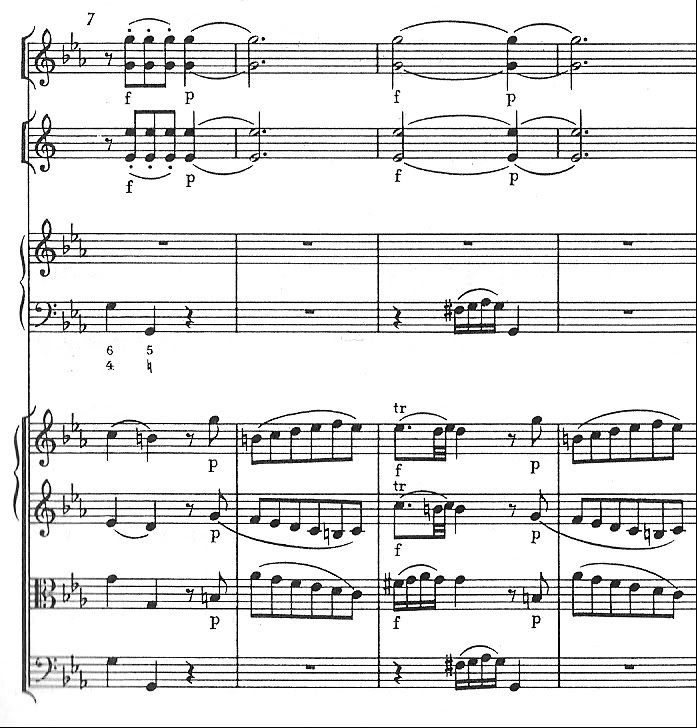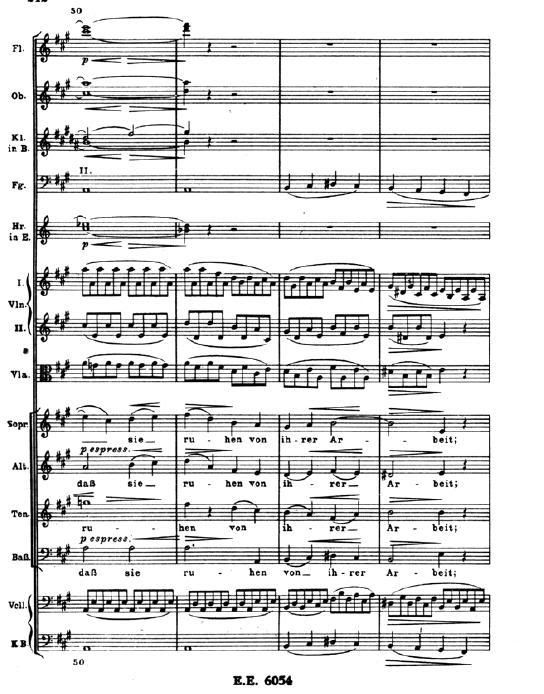|
Andy D
|
 |
« Reply #15 on: 23:19:08, 18-07-2007 » |
|
It is now, it wasn't before.
|
|
|
|
|
 Logged
Logged
|
|
|
|
|
richard barrett
Guest
|
 |
« Reply #16 on: 01:09:56, 19-07-2007 » |
|
Isn't my modestly shrunk version visible gosh! |
|
|
|
|
 Logged
Logged
|
|
|
|
|
Chafing Dish
Guest
|
 |
« Reply #17 on: 16:51:38, 19-07-2007 » |
|
If we want to fetishize false relations, my favorite happens in the Largo from CPE Bach's cello concerto in A Major (Wq. 172)
A fantastic recording existeth among Anner Bylsma and the Orch of the Age of Enlightenment.
|
|
|
|
|
 Logged
Logged
|
|
|
|
|
oliver sudden
|
 |
« Reply #18 on: 21:00:14, 05-08-2007 » |
|
I was fortunate enough to have a University lecturer (by the name of John O'Donnell) who was well up in the ins and outs of musica ficta. He managed to establish to at least my complete satisfaction that the circumstances under which most Renaissance vocal polyphony was performed (no score, no pencils, whole choir gathered around a partbook) meant that a heck of a lot of simultaneous false relations were unavoidable and must have been part of the sound. The reason they're now more closely associated with the English repertoire is that the English composers actually notated what continental composers in general left up to the ficta conventions...
Technically 'false relation' usually describes the use of the same scale degree in two different inflections in adjacent chords (which in common-practice harmony is one of those 'errors' like parallel fifths); the crunchy effect we're talking about is sometimes called a simultaneous false relation as I called it above. C# against D wouldn't technically be a false relation; Db against D would be, although not being particularly clever I can't see why Mahler wrote the note Mabel's talking about as a C#!
There are some lovely ones in the slow movement of the Brahms clarinet quintet, the downbeat of bar 8 for example...
|
|
|
|
|
 Logged
Logged
|
|
|
|
|
Chafing Dish
Guest
|
 |
« Reply #19 on: 14:56:59, 07-08-2007 » |
|
Here's that lovely Largo from CPE Bach. The cross-relation is at 3'37" http://www.sendspace.com/file/b1oue2Does this post seem strange to anyone? We are talking about a phenomenon that takes some 100 ms of time... why is it my favorite 100 ms in the entire concerto? |
|
|
|
|
 Logged
Logged
|
|
|
|
|
MabelJane
|
 |
« Reply #20 on: 21:23:49, 08-08-2007 » |
|
Here's that lovely Largo from CPE Bach. The cross-relation is at 3'37" http://www.sendspace.com/file/b1oue2Does this post seem strange to anyone? We are talking about a phenomenon that takes some 100 ms of time... why is it my favorite 100 ms in the entire concerto? Just very much enjoyed that Largo, Chafing Dish, thank you for the link. It is indeed a delicious moment at 3'37". For me, a clash in harmony like that is highly effective because the resolution is such an immediate relief - the false relation creates a fleeting but very intense moment of suspense. I don't know this CPE Bach concerto at all. I will be looking/listening out for it now. I was fortunate enough to have a University lecturer (by the name of John O'Donnell) who was well up in the ins and outs of musica ficta. He managed to establish to at least my complete satisfaction that the circumstances under which most Renaissance vocal polyphony was performed (no score, no pencils, whole choir gathered around a partbook) meant that a heck of a lot of simultaneous false relations were unavoidable and must have been part of the sound. The reason they're now more closely associated with the English repertoire is that the English composers actually notated what continental composers in general left up to the ficta conventions...
This is interesting, Oliver.
There are some lovely ones in the slow movement of the Brahms clarinet quintet, the downbeat of bar 8 for example...
I love this quintet but I don't remember false relations in the slow movement. Haven't heard it for ages, must borrow the score and listen to it. |
|
|
|
|
 Logged
Logged
|
Merely corroborative detail, intended to give artistic verisimilitude to an otherwise bald and unconvincing narrative.
|
|
|
|
Chafing Dish
Guest
|
 |
« Reply #21 on: 01:21:13, 09-08-2007 » |
|
Just very much enjoyed that Largo, Chafing Dish, thank you for the link. It is indeed a delicious moment at 3'37". For me, a clash in harmony like that is highly effective because the resolution is such an immediate relief - the false relation creates a fleeting but very intense moment of suspense.
I don't know this CPE Bach concerto at all. I will be looking/listening out for it now.
I am very glad you liked it. It's a particularly mordant bit of writing, as there are only two parts at that moment (save the continuo's filler), so the C against C#, all in the same register, is particularly delicious. Now I am tempted to try to write a little essay on why those 100 milliseconds really are the "center" of the piece. Hm, perhaps another day. When you have listened to more of his works, I hope you will join us in the (currently dormant) CPE Bach thread. I really enjoy his music more consistently than that of his father, even if it doesn't reach anywhere near the same heights. |
|
|
|
|
 Logged
Logged
|
|
|
|
|
oliver sudden
|
 |
« Reply #22 on: 01:30:07, 09-08-2007 » |
|
Oo! Please sir! Please sir! Me sir! Me sir! Here's one of my favourites. Mozart piano concerto no. 9 KV 271, slow movement. Have a look at the downbeat of bar 9.  Now this being 1777, that trill starts on the upper note, probably dwelt on a little with something of a light stress. (We all know the feeling.) That means that on the downbeat itself are sounding F natural in the 1st violins, F# in the violas, and G in the oboes. Fair fell out of my chair when I first heard that. |
|
|
|
|
 Logged
Logged
|
|
|
|
|
Chafing Dish
Guest
|
 |
« Reply #23 on: 01:32:35, 09-08-2007 » |
|
a beaut.
|
|
|
|
|
 Logged
Logged
|
|
|
|
|
oliver sudden
|
 |
« Reply #24 on: 01:43:30, 09-08-2007 » |
|
 ...and here's the Brahms while I've got the scanner warmed up. Downbeat of bar 8, as I said (I think) - A# in 1st violin, A natural in 2nd violin. |
|
|
|
|
 Logged
Logged
|
|
|
|
|
MabelJane
|
 |
« Reply #25 on: 11:42:54, 09-08-2007 » |
|
 ...and here's the Brahms while I've got the scanner warmed up. Downbeat of bar 8, as I said (I think) - A# in 1st violin, A natural in 2nd violin. Thanks Oliver, I can hear it now, following your quote from the score to a convenient music excerpt from Amazon. The harmony's gorgeous but the false relation isn't that obvious to me - I find it hard to hear the 1st violin's low A# and the 2nd violin's A looks to me like an A flat in the score though it is an A natural... (confused but smiley smiley) I want to hear your Mozart Piano concerto trill now! Fair fell out of my chair when I first heard that.
Must be good! MJ  |
|
|
|
|
 Logged
Logged
|
Merely corroborative detail, intended to give artistic verisimilitude to an otherwise bald and unconvincing narrative.
|
|
|
|
Ian Pace
|
 |
« Reply #26 on: 11:46:56, 09-08-2007 » |
|
I always find this false relation very striking, from the last movement of Ein deutsches Requiem (bar 52):  In no sense a smooth harmonic transition, more of a sudden discontinuous shift, almost like a change of gear, perhaps to denote a certain exaltation at the thought of God's work? |
|
|
|
|
 Logged
Logged
|
'These acts of keeping politics out of music, however, do not prevent musicology from being a political act . . .they assure that every apolitical act assumes a greater political immediacy' - Philip Bohlman, 'Musicology as a Political Act'
|
|
|
|
|
|
MabelJane
|
 |
« Reply #28 on: 12:52:57, 09-08-2007 » |
|
Wonderful Oliver! (Both you and the false relation!) Mozart really relished that one - with the forte marking too. Nothing subtle about it! Many many thanks for going to the trouble of sending it. (My comment wasn't intended as a hint that you should!) This board's a constant source of entertainment and education for me.  |
|
|
|
|
 Logged
Logged
|
Merely corroborative detail, intended to give artistic verisimilitude to an otherwise bald and unconvincing narrative.
|
|
|
|
Tony Watson
Guest
|
 |
« Reply #29 on: 13:14:48, 09-08-2007 » |
|
I don't know what a false relation is (apart from someone pretending to be a long-lost uncle) but I suspect it's more than just a clash of semitones. But if we are talking about delicious clashes of notes (and I'm probably the only one who is) I'd like to nominate two of my favourites.
The first is in the 16th bar of the overture to Iolanthe. A wonderful opening to an opera. The other is in the first few bar of the marketplace in Pictures at an Exhibition - the second notes of each group of four, where there's just a B flat in the left hand and an A in the right hand. No other notes so Mussorgsky really was looking for a special effect, I think. It works much better on the piano than any orchestral version.
|
|
|
|
|
 Logged
Logged
|
|
|
|
|

